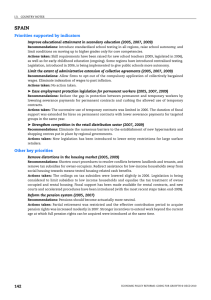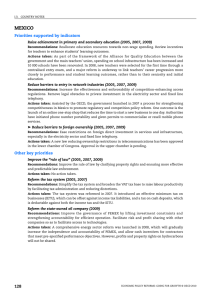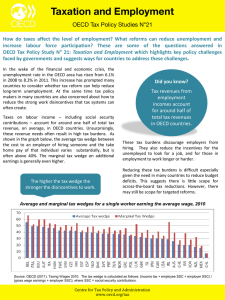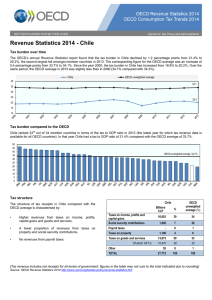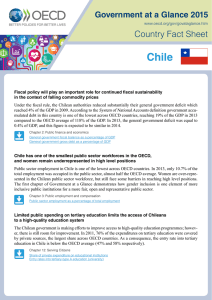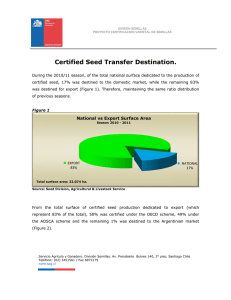Society at a Glance 2014 Highlights: CHILE OECD Social Indicators
Anuncio
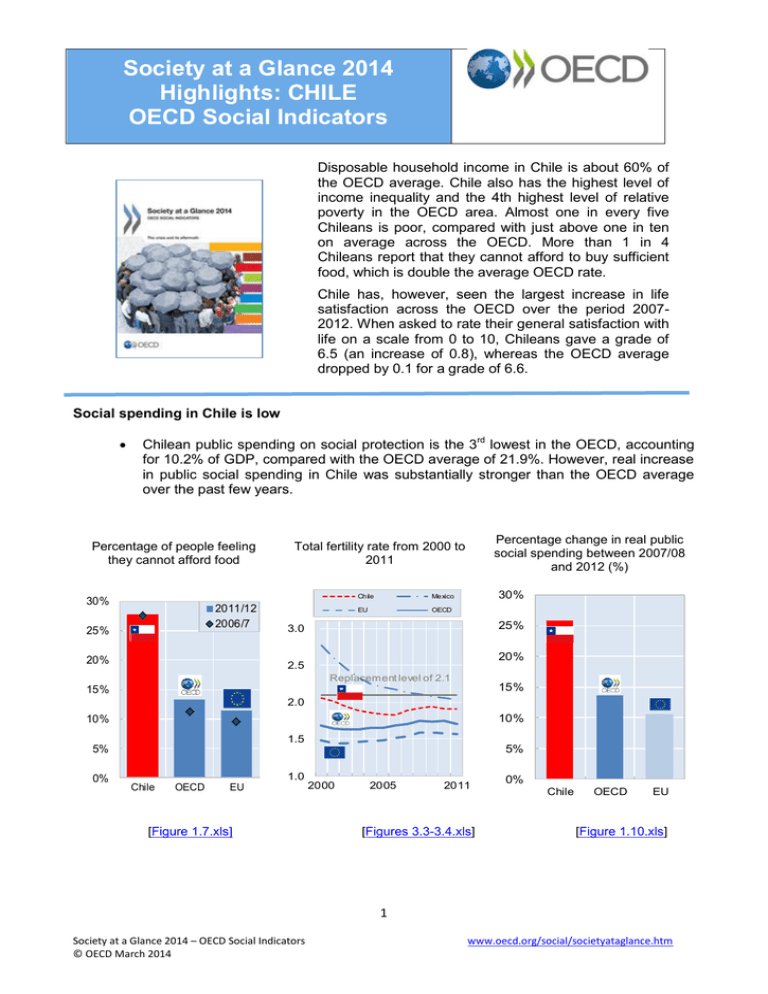
Society at a Glance 2014 Highlights: CHILE OECD Social Indicators Disposable household income in Chile is about 60% of the OECD average. Chile also has the highest level of income inequality and the 4th highest level of relative poverty in the OECD area. Almost one in every five Chileans is poor, compared with just above one in ten on average across the OECD. More than 1 in 4 Chileans report that they cannot afford to buy sufficient food, which is double the average OECD rate. Chile has, however, seen the largest increase in life satisfaction across the OECD over the period 20072012. When asked to rate their general satisfaction with life on a scale from 0 to 10, Chileans gave a grade of 6.5 (an increase of 0.8), whereas the OECD average dropped by 0.1 for a grade of 6.6. Social spending in Chile is low Chilean public spending on social protection is the 3rd lowest in the OECD, accounting for 10.2% of GDP, compared with the OECD average of 21.9%. However, real increase in public social spending in Chile was substantially stronger than the OECD average over the past few years. Percentage of people feeling they cannot afford food 30% 2011/12 2006/7 25% 20% Percentage change in real public social spending between 2007/08 and 2012 (%) Total fertility rate from 2000 to 2011 Chile Mexico EU OECD 30% 25% 3.0 20% 2.5 Replacement level of 2.1 15% 15% 2.0 10% 10% 1.5 5% 0% 5% 1.0 Chile OECD EU [Figure 1.7.xls] 2000 2005 2011 [Figures 3.3-3.4.xls] 0% Chile OECD EU [Figure 1.10.xls] 1 Society at a Glance 2014 – OECD Social Indicators © OECD March 2014 www.oecd.org/social/societyataglance.htm Strong increase in employment rates Employment rates in Chile increased by about 6 percentage points from 2007 to the second quarter of 2013, only exceeded by Israel. No other OECD country had a higher growth in employment rates for women, nearly 11 percentage points. Women in Chile can expect to live 19.1 years in retirement. The OECD average is 22.5 years. Chilean men can expect to spend three year less in retirement than the OECD average, 18.1 years. Chile has 6.3 people of working age for every person over the age of 65, well above the OECD average of 4.2. The old-age support ratio is expected to drop to 2.2 in 2050, slightly above the expected OECD average of 2.1. Confidence in national institutions dropped during the crisis Confidence in the national government and financial institutions decreased more in Chile during the crisis than the average of the OECD countries. Despite a relatively low level of confidence compared with the OECD average, Chile has reported a significant increase in people's feeling of safety while walking alone at night (an increase of 15 percentage points) since 2007. Confidence in local police also increased substantially during the same period (+10 percentage points). 2 Society at a Glance 2014 – OECD Social Indicators © OECD March 2014 www.oecd.org/social/societyataglance.htm Scoreboard: selected social indicators (Click on indicators for full data and information) Pre-crisis Latest year Chile EU OECD Chile EU OECD 4 636 000 643 700 .. .. .. .. 4 904 200 755 700 .. .. .. .. 12 400 1 700 22 900 7 900 23 100 7 300 13 200 2 000 22 900 7 700 23 100 7 100 1.92 1.63 1.75 1.91 1.59 1.70 6.7 6.6 5.9 6.2 11.1 9.1 .. 10.7 11.5 .. 12.7 12.6 Income inequality: Gini coefficient Gap between richest and poorest 10% 0.509 29.4 0.288 6.9 0.313 9.2 0.501 26.5 0.291 7.4 0.313 9.5 Relative poverty (%) 19.2 9.2 11.2 18.0 9.4 11.3 Share of people reporting not enough money to buy food (%) 27.6 9.5 11.2 27.8 11.5 13.2 Public social spending (% GDP) 9.5 22.5 19.6 10.2 25.1 21.9 Suicide rates, per 100 000 population 11.8 12.5 12.5 13.3 12.2 12.4 Health expenditure per capita (latest year USD PPPs) 1 200 3 100 3 100 1 600 3 200 3 300 Confidence in national government (%) 45 50 49 33 41 43 Confidence in financial institutions (%) 53 65 63 29 43 46 Annual disposable household income in national currency, latest year prices Average Bottom 10% in USD, latest year PPPs and prices Average Bottom 10% Total Fertility rate Unemployment rate (%) Youth neither in employment, education nor training, NEET rate (%) Unweighted average of the 21 EU and 34 OECD countries. from OECD Employment database from OECD Income Distribution Database from OECD Social Expenditure Database (SOCX) from OECD Health Data See also: • How does your country compare: data visualization (in Spanish ) • Executive summary: in your language 3 Society at a Glance 2014 – OECD Social Indicators © OECD March 2014 www.oecd.org/social/societyataglance.htm
